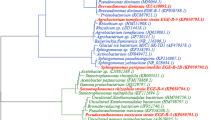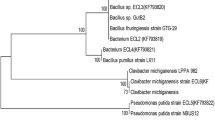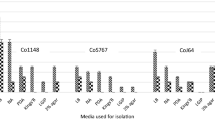Abstract
In the present investigation, five endophytic bacterial strains isolated from the roots of Cassia tora L. were identified as Bacillus subtilis, Agrobacterium tumefaciens, Bacillus sp., Pseudomonas putida, and Pseudomonas sp. based on biochemical characteristics as well as 16S rRNA gene sequencing. Isolates were screened for plant growth promoting traits, antibacterial activity, antifungal activity, antibiotic sensitivity, and salinity tolerance. The majority of the endophytic strains produced phytohormone indole acetic acid (IAA), ammonia, and also solubilized phosphate. Siderophore and HCN production were observed in A. tumefaciens, P. putida, and Pseudomonas sp. The antibiotic sensitivity profile indicated that the isolates were resistant to chloramphenicol, while highly susceptible to neomycin and streptomycin. Bacterial endophytes gave a definite stamp on their antibacterial activity against Escherichia coli and Klebsiella pneumoniae and antifungal activity against Pythium ultimum, Aureobasidium pullulans, and Alternaria alternata. Pseudomonas sp. showed maximum salt tolerance (6 % NaCl) contrary to A. tumefaciens that was least tolerant.

Similar content being viewed by others
References
Arunachalam C, Gayathri P (2010) Studies on bioprospecting of endophytic bacteria from the medicinal plant of Andrographis paniculata for their antimicrobial activity and antibiotic susceptibility. Int J Curr Pharm Res 2(4):63–8
Arachevaleta M, Bacon CW, Hoveland CS, Radclife DE (1989) Effect of tall fescue endophyte on plant response to environmental stress. Agron J 81:83–90
Bakker AW, Schippers B (1987) Microbial cyanide production in the rhizosphere in relation to potato yield reduction and Pseudomonas spp-mediated plant growth stimulation. Soil Biol Biochem 19:451–457
Bal HB, Nayak L, Das S, Adhya TK (2013) Isolation of ACC deaminase producing PGPR from rice rhizosphere and evaluating their plant growth promoting activity under salt stress. Plant Soil 366:93–105
Bauer AW, Kirby WMM, Sherris JC, Turck M (1996) Antibiotic susceptibility testing by a standardized single disk method. Am J Clin Pathol 45(4):493–6
Berg G, Eberl L, Hartmann A (2005) The rhizosphere as a reservoir for opportunistic human pathogenic bacteria. Environ Microbiol 7:1673–1685
Brick JM, Bostock R, Silverstone SE (1991) Rapid in situ assay for indoleacetic acid production by bacteria immobilized on nitrocellulose membrane. Appl Environ Microbiol 57:535–538
Bhore SJ, Nithya R, Loh CY (2010) Screening of endophytic bacteria isolated from leaves of Sambung Nyawa [Gynura procumbens (Lour.) Merr.] forcytokinin-like compounds. Bioinformation 5:191–7
Cappuccino JG, Sherman N (1992) Biochemical activities of microorganisms. In: Microbiology, A Laboratory Manual. The Benjamin/Cummings Publishing Co. California, USA
Christina A, Christapher V, Bhore SJ (2013) Endophytic bacteria as a source of novel antibiotics: An overview. Pharmacogn Rev 7(13):11–16
Compant S, Reiter B, Sessitsch A, Nowak J, Clément C, Ait Barka E (2005) Endophytic colonization of Vitis vinifera L. by a plant growth-promoting bacterium, Burkholderia sp. strain PsJN. Appl Environ Microbiol 71:1685–1693
Conrath U, Beckers GJM, Flors V, García-Agustín P, Jakab G, Mauch F (2006) Priming: getting ready for battle. Mol Plant-Microbe Interact 19:1062–71
Demain AL (1981) Industrial microbiology. Science 214:987–994
Fassiatova O (1983) Microscopic fungi in technical microbiology 1sted (In Polish). Wydawnictwo Naukowo-Techniczne, Warszawa
Germaine K, Liu X, Cabellos G, Hogan J, Ryan D, Dowling DN (2006) Bacterial endophyte-enhanced phyto-remediation of the organochlorine herbicide 2,4-dichlorophenoxyacetic acid. FEMS Microbiol Ecol 57:302–310
Goryluk A, Rekosz-Burlaga H, Blaszczyk M (2009) Isolation and characterization of bacterial endophytes of Chelidonium majus L. Pol J Microbiol 58(4):355–361
He CQ, Tan GE, Liang X, Du W, Chen YL, Zhi GY, Zhu Y (2010) Effect of Zn-tolerant bacterial strains on growth and Zn accumulation in Orychophragmus violaceus. Appl Soil Ecol 44:1–5
Holt JG, Krieg NR, Sneath PHA, Staley JT, Williams ST (1994) Bergey’s manual of determinative bacteriology. Williams and Wilkins, USA
Jain S, Patil UK (2010) Phytochemical and pharmacological profile of Cassia tora L.: An overview. Indian J Nat Prod Resour 1(4):430–437
Jousset A, Becker J, Chatterjee S, Karlovsky P, Scheu S, Eisenhauer N (2014) Biodiversity and species identity shape the antifungal activity of bacterial communities. Ecology 95:1184–90
Kaimi E, Mukaidani T, Tamaki M (2007) Screening of twelve plant species for phytoremediation of petroleum hydrocarbon-contaminated soil. Plant Prod Sci 10:211–218
Khan MS, Zaidi A, Wani PA (2006) Role of phosphate solubilizing microorganisms in sustainable agriculture - A review. Agron Sustain Dev 26:1–15
Khan Z, Doty SL (2009) Characterization of bacterial endophytes of sweet potato plants. Plant Soil 322:197–207
King EO, Ward MK, Randey DE (1954) Two simple media for the demonstration of pyocyanin and fluorescein. J Lab Clin Med 44:301–307
Kumar B, Kumar MS, Annapurna K, Maheshwari DK (2006) Genetic diversity of plant growth-promoting rhizobia isolated from a medicinal legume, Mucuna pruriens Linn. Curr Sci 91:1524–1529
Lamit LJ, Lau MK, Sthultz CM, Wooley SC, Whitham TG, Gehring CA (2014) Tree genotype and genetically based growth traits structure twig endophyte communities. Am J Bot 101(3):467–78
Leon M, Yaryura PM, Montecchia MS, Hernandez AI, Correa OS, Pucheu NL, Kerber NL, Garcia AF (2009) Antifungal activity of selected indigenous Pseudomonas and Bacillus from the soybean rhizosphere. International Journal of Microbiology Volume 2009, Article ID 572049, 9 pages
Liu J, Wang ET, Ren DW, Chen WX (2010) Mixture of endophytic Agrobacterium and Sinorhizobium meliloti strains could induce nonspecific nodulation on some woody legumes. Arch Microbiol 192:229–234
Ma Y, Rajkumar M, Freitas H (2009) Isolation and characterization of Ni mobilizing PGPB from serpentine soils and their potential in promoting plant growth and Ni accumulation by Brassica spp. Chemosphere 75:719–25
Marques APGC, Pires C, Moreira H, Rangel AOSS, Castro PML (2010) Assessment of the plant growth promotion abilities of six bacterial isolates using Zea mays as indicator plant. Soil Biol Biochem 42:1229–1235
Meena AK, Niranjan US, Yadav AK, Singh B, Nagaria AK, Rao MM (2010) Cassia tora Linn.: A review on its ethanobotany, phytochemical and pharmacological profile. J Pharm Res 3(3):557–560
Nagarajkumar M, Bhaskaran R, Velazhahan R (2004) Involvement of secondary metabolites and extracellular lytic enzymes produced by Pseudomonas fluorescens in inhibition of Rhizoctonia solani, the rice sheath blight pathogen. Microbiol Res 159:73–81
Nair DN, Padmavathy S (2014) Impact of endophytic microorganisms on plants, environment and humans. The Scientific World Journal, Vol. 2014, Article ID 250693, 11 pages
Owen NL, Hundley N (2004) Endophytes- the chemical synthesizers inside plants. Sci Prog 87:79–99
Pikovskaya RI (1948) Mobilization of phosphorous in soil in connection with the vital activity of some microbial species. Mikrobiologiya 17:362–370
Porteous NB, Grooters AM, Redding SW, Thomson EH, Rinaldi MG, De Hoog GS, Sutton DA (2003) Identification of Exophiala mesophila isolated from treated dental unit waterlines. J Clinic Microbiol 41: 3885–3889
Rajkumar M, Nagendran R, Lee KJ, Lee WH, Kim SZ (2006) Influence of plant growth promoting soil bacteria and Cr6+ on the growth of Indian mustard. Chemosphere 62:741–8
Rashid S, Charles TC, Glick BR (2012) Isolation and characterization of new plant growth promoting bacterial endophyte. Appl Soil Ecol 61:217–224
Reiter B, Sessitsch A (2006) Bacterial endophytes of the wildflower Crocus albiflorus analyzed by characterization of isolates and by a cultivation independent approach. Can J Microbiol 52:140–149
Rosenblueth M, Martinez-Romero E (2006) Bacterial endophytes and their interactions with hosts. Mol Plant Microbe Interact 19(8):827–37
Ryan RP, Germaine K, Franks A, Ryan DJ, Dowling DN (2008) Bacterial endophytes: recent developments and applications. FEMS Microbiol Lett 278:1–9
Schippers B, Bakker AW, Bakker R, van Peer R (1990) Beneficial and deleterious effects of HCN-producing Pseudomonads on rhizosphere interactions. Plant Soil 129:75–83
Schwyn B, Neilands JB (1987) Universal chemical assay for the detection and determination of siderophores. Anal Biochem 160:47–56
Shweta S, Hima BJ, Raghu J, Suma HK, Manjunatha BL, Mohana KP, Ravikanth G, Nataraja KN, Ganeshaiah KN, Shaanker UR (2013) Isolation of endophytic bacteria producing the anti-cancer alkaloid camptothecine from Miquelia dentata Bedd. (Icacinaceae). Phytomedicine 20:913–917
Strobel G, Daisy B (2003) Bioprospecting for microbial endophytes and their natural products. Microbiol Mol Biol Rev 67:491–502
Sullivan A, Edlund C, Nord CE (2001) Effect of antimicrobial agents on the ecological balance of human microflora. Lancet Infect Dis 1(2):101–14
Tamura K, Peterson D, Peterson N, Stecher G, Nei M, Kumar S (2011) MEGA5: molecular evolutionary genetics analysis using maximum likelihood, evolutionary distance and maximum parsimony methods. Mol Biol Evol 28:2731–2739
Wani PA, Khan MS, Zaidi A (2007) Effect of metal tolerant plant growth promoting Bradyrhizobium sp. (vigna) on growth, symbiosis, seed yield and metal uptake by green gram plants. Chemosphere 70:36–45
Whipps JM (2001) Microbial Interactions and biocontrol in the rhizophere. J Exp Bot 52:487–511
Williston EH, Zia-Walrath P, Youmans GP (1947) Plate methods for testing antibiotic activity of actinomycetes against virulent human type tubercle bacilli. J Bacteriol 54(5):563–8
Yousaf S, Afzal M, Reichenauer TG, Brady CL, Sessitsch A (2011) Hydrocarbon degradation, plant colonization and gene expression of alkane degradation genes by endophytic Enterobacter ludwigii strains. Environ Pollut 159:2675–2683
Acknowledgments
The authors are thankful to the University Grant Commission for providing RGN-JRF and RGN-SRF to Mr Vikas Kumar, and the Head, Department of Botany, Banaras Hindu University for providing necessary lab facility. We extend our sincerest thanks to Mr Zeeshan-ur-Rahman, University of Delhi for his kind assistance during experimental work.
Author information
Authors and Affiliations
Corresponding author
Rights and permissions
About this article
Cite this article
Kumar, V., Kumar, A., Pandey, K.D. et al. Isolation and characterization of bacterial endophytes from the roots of Cassia tora L. Ann Microbiol 65, 1391–1399 (2015). https://doi.org/10.1007/s13213-014-0977-x
Received:
Accepted:
Published:
Issue Date:
DOI: https://doi.org/10.1007/s13213-014-0977-x




